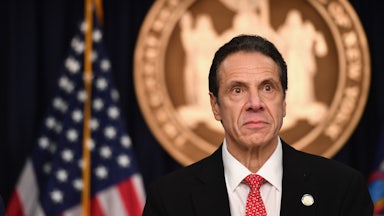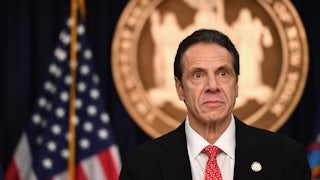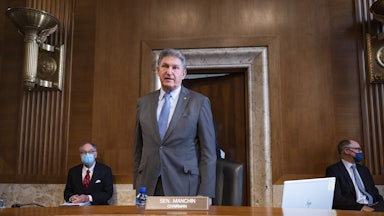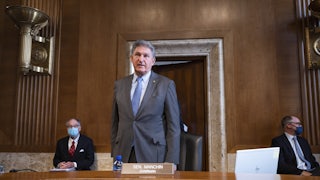Ten years ago, Donald Trump gave a speech at CPAC that electrified his fans and teased a future run for the presidency. On Sunday, he did it again. An extraordinary decade in American politics and American life perfectly bookended. Somehow, despite all that’s happened, we’re back where we started—wondering what Trump will do next. But it’s the wrong question, and Trump knows it. His rise as a political figure depended first upon Republican ambivalence and then upon their willingness to embrace and stand by him as a candidate and as president. Now that he’s cost them Congress and the White House and given the party further reason to abandon him, the real question is what Republicans will do with Trump.
There was speculation in January that Trump might settle the matter by starting another party. But this was always fairly unlikely. A Trump party would lose a lot of races, and beyond the damage those defeats would do to his personal pride, Trump must also understand by now that a failed electoral project would only marginalize and weaken him further. So it shouldn’t have been a surprise that he dedicated the first few minutes of his CPAC speech to shutting that talk down. “That was fake news,” he said. “Wouldn’t that be brilliant? Let’s start a new party, and let’s divide our vote so that you can never win. No, we’re not interested in that. Mr. McLaughlin just gave me numbers that nobody’s ever heard of before, more popular than anybody.”
Speaking of numbers, Trump won CPAC’s straw poll of potential presidential contenders for the very first time this weekend, taking 55 percent of the vote. By comparison, Cruz notched a first-place win in 2016 with 40 percent of the vote (Trump came in third with 15), and Mitt Romney narrowly beat then-Senator Rick Santorum with 38 percent in 2012. But Trump is still pulling north of 80 percent favorability among Republican voters, while only 68 percent of CPAC’s attendees believed he should even run again. Taken together, the results are another sign that Republican activists and connected politicos—the types that flock to CPAC every year—are less sure the party needs him than the party’s voters are.
The bulk of his speech can be read as an argument to the skeptics and an argument founded on the premise that Republicans can still win with him around if they redouble their efforts to suppress the Democratic electorate: more voter ID laws, more restrictions on mail balloting, more lies about illegal voting, and more ad hoc moves to challenge legitimate voters on the basis of those lies. “It has taken place for years in Pennsylvania and Detroit and various other places, but never like this, because they used Covid as a way of cheating,” he said. “And everybody knows it. Hundreds of thousands and millions of ballots. They used it as a way of getting what they’ve wanted for many years. And the Republicans have to do something about it.”
Trump’s refusal to accept the results of the election has always been about more than his ego, and it should be clear now that his future in Republican politics rests entirely upon how many leading figures in the party genuinely buy it: If the losses in November weren’t real, then sustaining Trump’s leadership of the party is less of a risk. This was the thinking animating his lie during the speech that “not a single Republican member of Congress lost their race for the first time in decades.” Actually, both Arizona’s Martha McSally and Colorado’s Cory Gardner did. And, of course, Georgia’s two Senate races went to the January runoffs that gave Democrats the Senate.
But the idea Trump wants to keep alive is that distancing him is electorally dangerous. And his speech featured a long list of critical Republicans he hopes will prove his point when they’re next up for reelection—“grandstanders like Mitt Romney, little Ben Sasse, Richard Burr, Bill Cassidy, Susan Collins, Lisa Murkowski, Pat Toomey; and in the House, Tom Rice, South Carolina, Adam Kinzinger, Dan Newhouse, Anthony Gonzalez. That’s another beauty,” he said. “Fred Upton, Jamie Herrera Butler, Peter Meyer, John Katko, David Valadeo. And of course the warmonger, a person that loves seeing our troops fighting, Liz Cheney.” Taking them down will surely be among the goals of the super PAC he and his advisers are setting up, although their specific plans remain opaque.
So does “Trumpism.” Toward the end of his speech, presumably at someone else’s urging, Trump tried to offer a definition of the term: “great deals” on trade, low taxes, deregulation, immigration restrictions, military strength, support for the police, and national pride. But aside from free trade skepticism—now shared across the political spectrum and by a growing number of economists anyhow—nothing on this list amounts to a departure from what has been Republican policy consensus since the end of the Bush administration. Trump may have managed to Trumpify the Republican Party in political style, but too little has been said about how the GOP managed to Republicanize Trump in substance.
But fortunately for him, style is winning out. That’s plain not only in the rise and antics of figures like Representative Marjorie Taylor Greene, but in remarks like those of Florida Governor Ron DeSantis, who probably rode a home-state advantage to his second-place finish behind Trump in the straw poll and, in his opening day speech to the conference, dismissed the importance of a concrete agenda relative to combating “cancel culture.” “We can sit around and have academic debates about conservative policy,” he told the crowd. “But the question is, when the Klieg lights get hot, when the left comes after you: Will you stay strong, or will you fold?”
Both DeSantis and Trump offered attendees a picture of their opponents the left wouldn’t actually recognize. “They always stick together,” Trump said of Democrats on Sunday. “You don’t have Mitt Romneys in the group.” It was another hilarious lie, but one that should encourage thought as to the role Democratic divisions might play in shaping the future of the GOP and Trump’s role in it. If Democrats really do manage to unite in support of challenging the right’s structural power and passing the Biden agenda, actually winning elections may take on a new urgency for both the right’s wonks and posturing culture warriors alike. And they’ll have even more reason to size Trump up accurately—as a huckster whose narrow victory in 2016 can be credited entirely to the structure of the American electoral system, and who’s spelled electoral doom for the GOP ever since. Try as Republicans might to idolize him in gold, the man isn’t immortal, in any sense. He’ll be a tough act to follow, culturally and emotionally, but sooner or later they will have to follow him.








